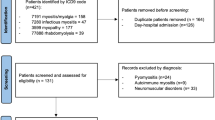Abstract
POEMS syndrome is a rare plasma cell dyscrasia characterized by polyneuropathy, organomegaly, endocrinopathy, M protein, and skin changes. This study reviewed the clinical characteristics and long-term outcome of 99 consecutive Chinese patients with newly diagnosed POEMS syndrome in a single institute. The median age of 99 patients was 45 years, and the ratio of men/women was 1.4. The median time from onset of symptoms to diagnosis was 18 months. The typical five features of peripheral neuropathy, organomegaly, endocrinopathy, M protein, and skin change remained to be essential for patients with POEMS syndrome in China. The unusual features like pulmonary hypertension (36%) and renal impairment (37%) were not uncommon in China. Eighty-three percent patients were alive after follow-up time of 25 months, and 10% patients had survived more than 60 months. Melphalan-based therapy (OR, 0.076; 95% CI, 0.02–0.285) and normal renal function (OR, 0.246; 95% CI, 0.076–0.802) were independent prognostic factors for the survival of patients with POEMS syndrome. In conclusion, POEMS syndrome in Chinese patients was a multi-systemic disease with clinical features similar to non-Chinese ones. Active therapy can effectively improve the prognosis of patients with POEMS syndrome.


Similar content being viewed by others
References
Dispenzieri A (2007) POEMS syndrome. Blood Rev 21:285–299
Watanabe O, Arimura K, Kitajima I et al (1996) Greatly raised vascular endothelial growth factor (VEGF) in POEMS syndrome. Lancet 347:702
Nakanishi T, Sobue I, Toyokura Y et al (1984) The Crow–Fukase syndrome: a study of 102 cases in Japan. Neurology 34:712–720
Dispenzieri A, Kyle RA, Lacy MQ et al (2003) POEMS syndrome: definitions and long-term outcome. Blood 101:2496–2506
Zhu WG, Wang Y, Zeng XJ et al (2006) A clinical analysis of 32 cases of POEMS syndrome. Zhonghua Nei Ke Za Zhi 45:108–111
Zhang B, Song X, Liang B et al (2010) The clinical study of POEMS syndrome in China. Neuro Endocrinol Lett 31:229–237
Cui R, Huang X, Shi Q et al (2010) POEMS syndrome in China. Intern Med J. doi:10.1111/j.1445-5994.2010.02172.x
Dupont SA, Dispenzieri A, Mauermann ML et al (2009) Cerebral infarction in POEMS syndrome: incidence, risk factors, and imaging characteristics. Neurology 73:1308–1312
Soubrier MJ, Dubost JJ, Sauvezie BJ (1994) POEMS syndrome: a study of 25 cases and a review of the literature. French Study Group on POEMS Syndrome. Am J Med 97:543–553
Donaghy M, Hall P, Gawler J et al (1989) Peripheral neuropathy associated with Castleman’s disease. J Neurol Sci 89:253–267
Allam JS, Kennedy CC, Aksamit TR et al (2008) Pulmonary manifestations in patients with POEMS syndrome: a retrospective review of 137 patients. Chest 133:969–974
Jouve P, Humbert M, Chauveheid MP et al (2007) POEMS syndrome-related pulmonary hypertension is steroid-responsive. Respir Med 101:353–355
Nakamoto Y, Imai H, Yasuda T et al (1999) A spectrum of clinicopathological features of nephropathy associated with POEMS syndrome. Nephrol Dial Transplant 14:2370–2378
Sano M, Terasaki T, Koyama A et al (1986) Glomerular lesions associated with the Crow–Fukase syndrome. Virchows Arch A Pathol Anat Histopathol 409:3–9
Kuwabara S, Dispenzieri A, Arimura K et al (2008) Treatment for POEMS (polyneuropathy, organomegaly, endocrinopathy, M-protein, and skin changes) syndrome. Cochrane Database Syst Rev (4):CD006828
Kuwabara S, Hattori T, Shimoe Y et al (1997) Long term melphalan-prednisolone chemotherapy for POEMS syndrome. J Neurol Neurosurg Psychiatry 63:385–387
Dispenzieri A, Moreno-Aspitia A, Suarez GA et al (2004) Peripheral blood stem cell transplantation in 16 patients with POEMS syndrome, and a review of the literature. Blood 104:3400–3407
Palladini G, Perfetti V, Obici L et al (2004) Association of melphalan and high-dose dexamethasone is effective and well tolerated in patients with AL (primary) amyloidosis who are ineligible for stem cell transplantation. Blood 103:2936–2938
Comenzo RL (2009) How I treat amyloidosis. Blood 114:3147–3157
Author information
Authors and Affiliations
Corresponding author
Rights and permissions
About this article
Cite this article
Li, J., Zhou, DB., Huang, Z. et al. Clinical characteristics and long-term outcome of patients with POEMS syndrome in China. Ann Hematol 90, 819–826 (2011). https://doi.org/10.1007/s00277-010-1149-0
Received:
Accepted:
Published:
Issue Date:
DOI: https://doi.org/10.1007/s00277-010-1149-0




